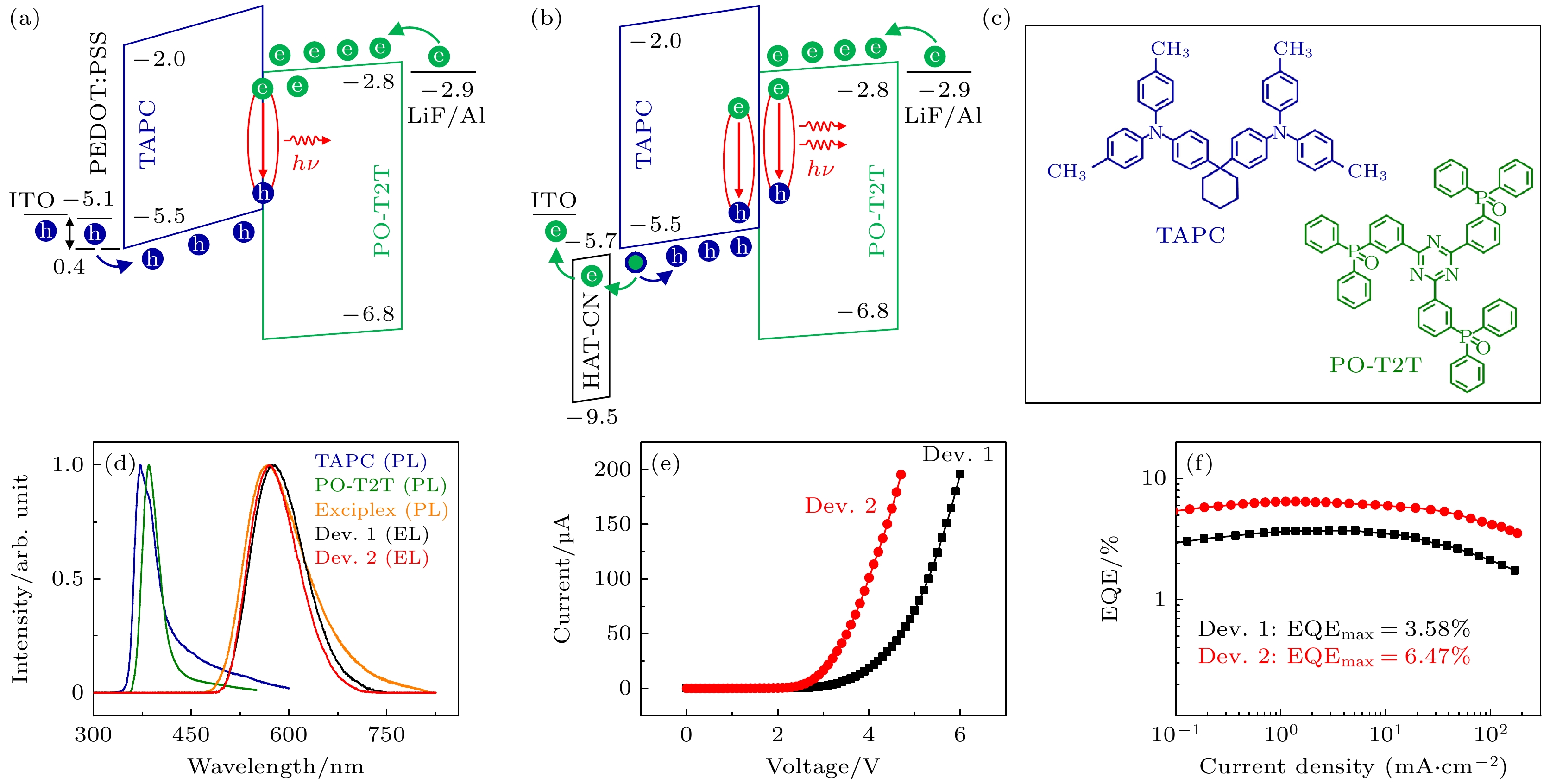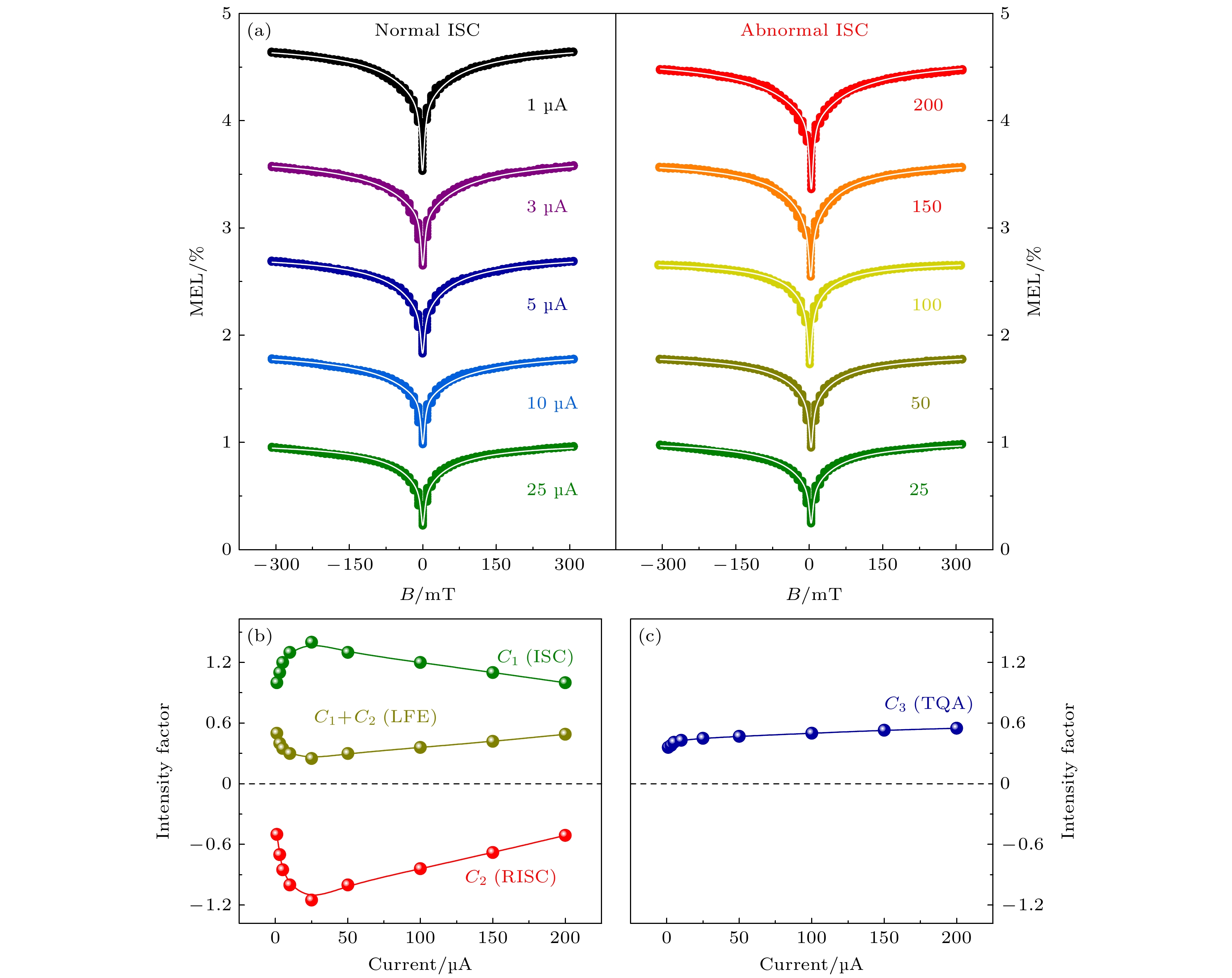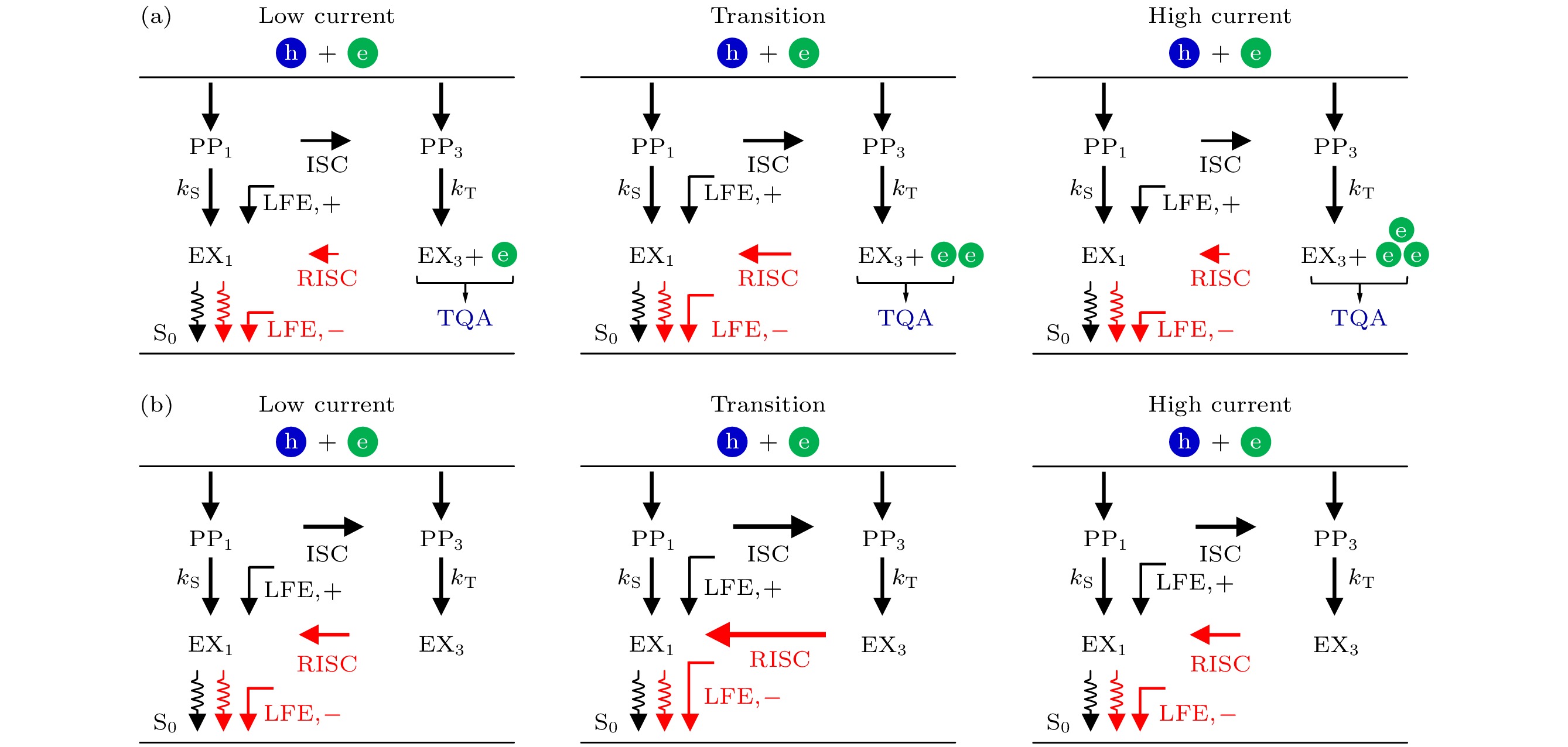-
激基复合物有机发光二极管(exciplex-based organic light-emitting diodes, EB-OLEDs)中自旋对态(spin-pair states)的系间窜越(intersystem crossing, ISC)和反向系间窜越(reverse ISC, RISC)是重要的自旋混合过程. 它们通常展示正常的电流依赖关系, 即随电流的增大而减弱. 本文利用磁电致发光(magneto-electroluminescence, MEL)作为指纹式探测工具, 在具有不同电荷平衡的EB-OLEDs中观察到多种电流依赖的ISC和RISC过程. 它们有趣的表现为: 随着器件注入电流增大, 非平衡器件中电流依赖的MEL曲线呈现从正常ISC (1—25 μA)向反常ISC (25—200 μA)过程的转换, 而平衡器件中电流依赖的MEL曲线则展示从正常ISC (1—5 μA)→反常RISC (10—50 μA)→正常RISC (50—150 μA)→反常ISC (200—300 μA)过程的转换. 通过拟合和解析MEL曲线, 发现非平衡和平衡器件中的ISC和RISC过程随着电流增大都先增强后减弱. 这些丰富而有趣的转换可归因于增大电流时自旋对态增加的数量与其减短的寿命之间的竞争. 此外, 平衡器件中的RISC过程比非平衡器件中的更强, 从而导致平衡器件的外量子效率比非平衡器件的更高. 显然, 本文不但加深了对EB-OLEDs中电流依赖的ISC和RISC过程的理解, 还为设计制作高效率EB-OLEDs提供了清晰的器件物理思路.Intersystem crossing (ISC) and reverse ISC (RISC) between singlet and triplet polaron-pair and exciplex state are important spin-mixing processes in exciplex-based organic light-emitting diodes (EB-OLEDs). These two processes usually show normal current dependence which weakens with the increase of bias-current. This is because the bias-current increases by improving the device bias-voltage. When the bias-voltage rises, the electric field within the device is enhanced, which facilitates the electric-field-induced dissociation of polaron-pair and exciplex states and then reduces their lifetime. That is, less polaron-pair and exciplex states participate in the ISC process and RISC process, leading these two processes to weaken. Here, magneto-electroluminescence (MEL) is used as a fingerprint probing tool to observe various current-dependent ISC and RISC processes in EB-OLEDs with different charge balances via modifying the device hole-injection layer. Interestingly, current-dependent MEL traces of the unbalanced device display a conversion from normal ISC (1–25 μA) process to abnormal ISC (25–200 μA) process, whereas those of the balanced device show conversions from normal ISC (1–5 μA) into abnormal RISC (10–50 μA) and then into normal RISC (50–150 μA) and finally into abnormal ISC (200–300 μA) process. By fitting and decomposing the current-dependent MEL traces of the unbalanced and balanced devices, we find that the ISC process and RISC process in these two devices first increase then decrease as the bias-current increases. These non-monotonic current-dependent ISC process and RISC process are attributed to the competition between the increased number and the reduced lifetime of polaron-pair state and exciplex state during improving the bias-current. Furthermore, the RISC process in the balanced device is stronger than that in the unbalanced device. This is because the balanced carrier injection can facilitate the formation of triplet exciplex states and weaken the triplet-charge annihilation (TQA) process between triplet exciplex states and excessive charge carriers, which leads the number of triplet exciplex states to increase. That is to say, more triplet exciplex states can be converted into singlet exciplex states through the RISC process, causing the external quantum efficiency of the balanced device to be higher than that of the unbalanced device. Obviously, this work not only deepens the understandings of current-dependent ISC and RISC processes in EB-OLEDs, but also provides an insight into the device physics for designing and fabricating high-efficiency EB-OLEDs.
-
Keywords:
- exciplex /
- magneto-electroluminescence /
- intersystem crossing /
- reverse intersystem crossing
[1] Yuan P S, Qiao X F, Yan D H, Ma D G 2018 J. Mater. Chem. C 6 5721
 Google Scholar
Google Scholar
[2] Zhang B H, Xie Z Y 2019 Front. Chem. 7 306
 Google Scholar
Google Scholar
[3] Yang H Y, Zheng C J, Zhang M, Zhao J W, Shi Y Z, Pu C P, Lin H, Tao S L, Zhang X H 2022 Sci. China Mater. 65 460
 Google Scholar
Google Scholar
[4] Niu L B, Zhang Y, Chen L J, Zhang Q M, Guan Y X 2020 Org. Electron. 87 105971
 Google Scholar
Google Scholar
[5] Jin P F, Zhou Z Y, Wang H, Hao J J, Chen R, Wang J Y, Zhang C 2022 J. Phys. Chem. Lett. 13 2516
 Google Scholar
Google Scholar
[6] 吴雨廷, 朱洪强, 魏福贤, 王辉耀, 陈敬, 宁亚茹, 吴凤娇, 陈晓莉, 熊祖洪 2022 物理学报 71 227201
 Google Scholar
Google Scholar
Wu Y T, Zhu H Q, Wei F X, Wang H Y, Chen J, Ning Y R, Wu F J, Chen X L, Xiong Z H 2022 Acta Phys. Sin. 71 227201
 Google Scholar
Google Scholar
[7] Yuan P S, Guo X M, Qiao X F, Yan D H, Ma D G 2019 Adv. Optical Mater. 7 1801648
 Google Scholar
Google Scholar
[8] Chen P, Peng Q M, Yao L, Gao N, Li F 2013 Appl. Phys. Lett. 102 063301
 Google Scholar
Google Scholar
[9] Xu J, Tang X T, Zhao X, Zhu H Q, Qu F L, Xiong Z H 2020 Phys. Rev. Appl. 14 024011
 Google Scholar
Google Scholar
[10] Zhao X, Tang X T, Zhu H Q, Ma C H, Wang Y, Ye S N, Tu L Y, Xiong Z H 2021 ACS Appl. Electron. Mater. 3 3034
 Google Scholar
Google Scholar
[11] Deng J Q, Jia W Y, Chen Y B, Liu D Y, Hu Y Q, Xiong Z H 2017 Sci. Rep. 7 44396
 Google Scholar
Google Scholar
[12] 宁亚茹, 赵茜, 汤仙童, 陈敬, 吴凤娇, 贾伟尧, 陈晓莉, 熊祖洪 2022 物理学报 71 087201
 Google Scholar
Google Scholar
Ning Y R, Zhao X, Tang X T, Chen J, Wu F J, Jia W Y, Chen X L, Xiong Z H 2022 Acta Phys. Sin. 71 087201
 Google Scholar
Google Scholar
[13] Zhao C G, Zhao F G, Wang K, Yu H M, Huang T Y, Wang R, Zhang C X, Hu B, Duan L 2020 Phys. Rev. Appl. 14 034059
 Google Scholar
Google Scholar
[14] Xu Y W, Liang X M, Zhou X H, Yuan P S, Zhou J D, Wang C, Li B B, Hu D H, Qiao X F, Jiang X F, Liu L L, Su S J, Ma D G, Ma Y G 2019 Adv. Mater. 31 1807388
 Google Scholar
Google Scholar
[15] Zhang T T, Holford D F, Gu H, Kreouzis T, Zhang S J, Gillin W P 2016 Appl. Phys. Lett. 108 023303
 Google Scholar
Google Scholar
[16] 赵茜, 汤仙童, 潘睿亨, 许静, 屈芬兰, 熊祖洪 2019 科学通报 64 2514
 Google Scholar
Google Scholar
Zhao X, Tang X T, Pan R H, Xu J, Qu F L, Xiong Z H 2019 Chin. Sci. Bull. 64 2514
 Google Scholar
Google Scholar
[17] Mermer Ö, Veeraraghavan G, Francis T L, Sheng Y, Nguyen T D, Wohlgenannt M, Köhler A, Suti-Al M K, Khan M S 2005 Phys. Rev. B 72 205202
 Google Scholar
Google Scholar
[18] Wang Y F, Tiras K S, Harmon N J, Wohlgenannt M, Flatté M E 2016 Phys. Rev. X 6 011011
 Google Scholar
Google Scholar
[19] Zhu M P, Yuan X T, Ni G 2019 Micromachines 10 546
 Google Scholar
Google Scholar
[20] 王辉耀, 宁亚茹, 吴凤娇, 赵茜, 陈敬, 朱洪强, 魏福贤, 吴雨廷, 熊祖洪 2022 物理学报 71 217201
 Google Scholar
Google Scholar
Wang H Y, Ning Y R, Wu F J, Zhao X, Chen J, Zhu H Q, Wei F X, Wu Y T, Xiong Z H 2022 Acta Phys. Sin. 71 217201
 Google Scholar
Google Scholar
[21] Crooker S A, Liu F L, Kelley M R, Martinez N J D, Nie W Y, Mohite A D, Nayyar I H, Tretiak S, Smith D L, Ruden P P 2014 Appl. Phys. Lett. 105 153304
 Google Scholar
Google Scholar
[22] Liu F L, Kelley M R, Crooker S A, Nie W Y, Mohite A D, Ruden P P, Smith D L 2014 Phys. Rev. B 90 235314
 Google Scholar
Google Scholar
[23] Janssen P, Cox M, Wouters S H W, Kemerink M, Wienk M M, Koopmans B 2013 Nat. Commun. 4 2286
 Google Scholar
Google Scholar
[24] Peng Q M, Li A W, Fan Y X, Chen P, Li F 2014 J. Mater. Chem. C 2 6264
 Google Scholar
Google Scholar
[25] Bagnich S A, Niedermeier U, Melzer C, Sarfert W, Seggem H V 2009 J. Appl. Phys. 106 113702
 Google Scholar
Google Scholar
[26] Inal S, Schubert M, Sellinger A, Neher D 2010 J. Phys. Chem. Lett. 1 982
 Google Scholar
Google Scholar
[27] Li B B, Gan L, Cai X Y, Li X L, Wang Z H, Gao K, Chen D C, Cao Y, Su S J 2018 Adv. Mater. Interfaces 5 1800025
 Google Scholar
Google Scholar
[28] Hung W Y, Chiang P Y, Lin S W, Tang W C, Chen Y T, Liu S H, Chou P T, Hung Y T, Wong K T 2016 ACS Appl. Mater. Interfaces 8 4811
 Google Scholar
Google Scholar
-
图 1 器件的能级结构和光电特性 (a), (b) Dev. 1和Dev. 2的能级结构; (c) TAPC和PO-T2T的化学分子结构; (d) TAPC纯膜, PO-T2T纯膜和TAPC:PO-T2T共混薄膜的PL谱以及Dev. 1和Dev. 2的EL谱; (e) Dev. 1和Dev. 2的电流-电压特性曲线; (f) Dev. 1和Dev. 2的EQE-电流密度特性曲线
Fig. 1. Energy-level structures and photoelectric properties of devices: (a), (b) Energy-level structures of Dev. 1 and Dev. 2; (c) chemical molecular structures of TAPC and PO-T2T; (d) PL spectra from pure TAPC and PO-T2T films and TAPC:PO-T2T co-deposited film and EL spectra from Dev. 1 and Dev. 2; (e) current-voltage characteristics of Dev. 1 and Dev. 2; (f) EQE-current density characteristics of Dev. 1 and Dev. 2.
-
[1] Yuan P S, Qiao X F, Yan D H, Ma D G 2018 J. Mater. Chem. C 6 5721
 Google Scholar
Google Scholar
[2] Zhang B H, Xie Z Y 2019 Front. Chem. 7 306
 Google Scholar
Google Scholar
[3] Yang H Y, Zheng C J, Zhang M, Zhao J W, Shi Y Z, Pu C P, Lin H, Tao S L, Zhang X H 2022 Sci. China Mater. 65 460
 Google Scholar
Google Scholar
[4] Niu L B, Zhang Y, Chen L J, Zhang Q M, Guan Y X 2020 Org. Electron. 87 105971
 Google Scholar
Google Scholar
[5] Jin P F, Zhou Z Y, Wang H, Hao J J, Chen R, Wang J Y, Zhang C 2022 J. Phys. Chem. Lett. 13 2516
 Google Scholar
Google Scholar
[6] 吴雨廷, 朱洪强, 魏福贤, 王辉耀, 陈敬, 宁亚茹, 吴凤娇, 陈晓莉, 熊祖洪 2022 物理学报 71 227201
 Google Scholar
Google Scholar
Wu Y T, Zhu H Q, Wei F X, Wang H Y, Chen J, Ning Y R, Wu F J, Chen X L, Xiong Z H 2022 Acta Phys. Sin. 71 227201
 Google Scholar
Google Scholar
[7] Yuan P S, Guo X M, Qiao X F, Yan D H, Ma D G 2019 Adv. Optical Mater. 7 1801648
 Google Scholar
Google Scholar
[8] Chen P, Peng Q M, Yao L, Gao N, Li F 2013 Appl. Phys. Lett. 102 063301
 Google Scholar
Google Scholar
[9] Xu J, Tang X T, Zhao X, Zhu H Q, Qu F L, Xiong Z H 2020 Phys. Rev. Appl. 14 024011
 Google Scholar
Google Scholar
[10] Zhao X, Tang X T, Zhu H Q, Ma C H, Wang Y, Ye S N, Tu L Y, Xiong Z H 2021 ACS Appl. Electron. Mater. 3 3034
 Google Scholar
Google Scholar
[11] Deng J Q, Jia W Y, Chen Y B, Liu D Y, Hu Y Q, Xiong Z H 2017 Sci. Rep. 7 44396
 Google Scholar
Google Scholar
[12] 宁亚茹, 赵茜, 汤仙童, 陈敬, 吴凤娇, 贾伟尧, 陈晓莉, 熊祖洪 2022 物理学报 71 087201
 Google Scholar
Google Scholar
Ning Y R, Zhao X, Tang X T, Chen J, Wu F J, Jia W Y, Chen X L, Xiong Z H 2022 Acta Phys. Sin. 71 087201
 Google Scholar
Google Scholar
[13] Zhao C G, Zhao F G, Wang K, Yu H M, Huang T Y, Wang R, Zhang C X, Hu B, Duan L 2020 Phys. Rev. Appl. 14 034059
 Google Scholar
Google Scholar
[14] Xu Y W, Liang X M, Zhou X H, Yuan P S, Zhou J D, Wang C, Li B B, Hu D H, Qiao X F, Jiang X F, Liu L L, Su S J, Ma D G, Ma Y G 2019 Adv. Mater. 31 1807388
 Google Scholar
Google Scholar
[15] Zhang T T, Holford D F, Gu H, Kreouzis T, Zhang S J, Gillin W P 2016 Appl. Phys. Lett. 108 023303
 Google Scholar
Google Scholar
[16] 赵茜, 汤仙童, 潘睿亨, 许静, 屈芬兰, 熊祖洪 2019 科学通报 64 2514
 Google Scholar
Google Scholar
Zhao X, Tang X T, Pan R H, Xu J, Qu F L, Xiong Z H 2019 Chin. Sci. Bull. 64 2514
 Google Scholar
Google Scholar
[17] Mermer Ö, Veeraraghavan G, Francis T L, Sheng Y, Nguyen T D, Wohlgenannt M, Köhler A, Suti-Al M K, Khan M S 2005 Phys. Rev. B 72 205202
 Google Scholar
Google Scholar
[18] Wang Y F, Tiras K S, Harmon N J, Wohlgenannt M, Flatté M E 2016 Phys. Rev. X 6 011011
 Google Scholar
Google Scholar
[19] Zhu M P, Yuan X T, Ni G 2019 Micromachines 10 546
 Google Scholar
Google Scholar
[20] 王辉耀, 宁亚茹, 吴凤娇, 赵茜, 陈敬, 朱洪强, 魏福贤, 吴雨廷, 熊祖洪 2022 物理学报 71 217201
 Google Scholar
Google Scholar
Wang H Y, Ning Y R, Wu F J, Zhao X, Chen J, Zhu H Q, Wei F X, Wu Y T, Xiong Z H 2022 Acta Phys. Sin. 71 217201
 Google Scholar
Google Scholar
[21] Crooker S A, Liu F L, Kelley M R, Martinez N J D, Nie W Y, Mohite A D, Nayyar I H, Tretiak S, Smith D L, Ruden P P 2014 Appl. Phys. Lett. 105 153304
 Google Scholar
Google Scholar
[22] Liu F L, Kelley M R, Crooker S A, Nie W Y, Mohite A D, Ruden P P, Smith D L 2014 Phys. Rev. B 90 235314
 Google Scholar
Google Scholar
[23] Janssen P, Cox M, Wouters S H W, Kemerink M, Wienk M M, Koopmans B 2013 Nat. Commun. 4 2286
 Google Scholar
Google Scholar
[24] Peng Q M, Li A W, Fan Y X, Chen P, Li F 2014 J. Mater. Chem. C 2 6264
 Google Scholar
Google Scholar
[25] Bagnich S A, Niedermeier U, Melzer C, Sarfert W, Seggem H V 2009 J. Appl. Phys. 106 113702
 Google Scholar
Google Scholar
[26] Inal S, Schubert M, Sellinger A, Neher D 2010 J. Phys. Chem. Lett. 1 982
 Google Scholar
Google Scholar
[27] Li B B, Gan L, Cai X Y, Li X L, Wang Z H, Gao K, Chen D C, Cao Y, Su S J 2018 Adv. Mater. Interfaces 5 1800025
 Google Scholar
Google Scholar
[28] Hung W Y, Chiang P Y, Lin S W, Tang W C, Chen Y T, Liu S H, Chou P T, Hung Y T, Wong K T 2016 ACS Appl. Mater. Interfaces 8 4811
 Google Scholar
Google Scholar
计量
- 文章访问数: 5785
- PDF下载量: 66
- 被引次数: 0














 下载:
下载:



